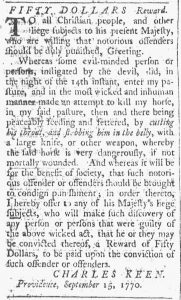What was advertised in a colonial American newspaper 250 years ago today?

“Cutting his throat, and stabbing him in the belly.”
The advertising section of the Providence Gazette in the early 1770s sometimes read like a late nineteenth-century police blotter. Consider the September 22, 1770, edition. Among the advertisements for consumer goods and services, legal notices, and one advertisement offering a good price for a flying squirrel, several other advertisements relayed stories of thefts and worse crimes.
The first recorded a theft, its tone suggesting unpleasant consequences for the thief. An anonymous advertiser suggested that the “Person who took a new Beaver Hat out of the Court-House” on the previous Thursday evening “will do well to leave it” at the printing office for the owner to retrieve. By doing so, the thief “may thereby prevent the disagreeable Circumstance of a personal Application.” Whether or not the advertiser actually knew the identity of the thief, he suggested that he did. The prospect of a “personal Application” suggested retribution for refusing to voluntarily return the hat.
In an advertisement that had already been running for many weeks, Seth Wetmore of Middletown, Connecticut, described how his house “was broke open … by some Person or Persons unknown” at the beginning of July. The burglars absconded with a variety of clothing and other personal articles. Wetmore suspected that they may have been the same men who escaped from the jail in New Haven the previous night, John Armstrong and John Galloway, and their accomplice, James Burne. Wetmore offered a reward for the return of his goods “or the greater Part of them” and the capture of the “Felons” over and above the reward offered by the jailer.
In the most disturbing of these advertisements, Charles Keen of Providence described the depraved acts of “notorious offenders … instigated by the devil.” An “evil-minded person or persons” had entered his pasture in the dead of night and attempted to kill his horse. The unfortunate horse had been “peaceably feeding and fettered” when the perpetrators set about “cutting his throat, and stabbing him in the belly, with a large knife, or other weapon.” The horse initially survived the ordeal, but Keen suspected that he could still die of the wounds. Keen offered a substantial reward to anybody “who will make such discovery of any person or persons that were guilty of the above wicked act.”
When it came to crime reporting, from a hat nicked at the courthouse to a brutal attack on a horse in the middle of the night, the advertisements in this issue of the Providence Gazette carried far more news than the rest of the newspaper.
